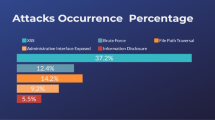Abstract
Safeguarding websites is of utmost importance nowadays because of a wide variety of attacks being launched against them. Moreover, lack of security awareness and widespread use of traditional security solutions like simple Web Application Firewalls (WAFs) has further aggravated the problem. Researchers have moved towards employing sophisticated machine learning and deep learning based techniques to counter common web attacks like the SQL injection (SQLi) and Cross Site Scripting (XSS). Lately, keen interest has been taken in tackling these attacks through cyber deception. In this paper, we propose an ensemble based deep learning approach by combining Convolutional Neural Network (CNN) and Long Short Term Memory (LSTM) models. This detection framework also contains a Session Maintenance Module (SMM) which maintains user state in an otherwise stateless protocol by analyzing cookies thereby providing further optimization. The proposed framework detects SQLi and XSS attacks with an accuracy of 99.83% and 99.47% respectively. Moreover, in order to engage attackers, a deception module based on dockers has been proposed which contains deceptive lures to engage the attacker. The deceptive module has the capability to detect zero-days and is more efficient when compared to other similar solutions.
Sponsored by the Higher Education Commission (HEC), Pakistan through its initiative of National Center for Cyber Security for the affiliated lab National Cyber Security Auditing and Evaluation Lab (NCSAEL), Grant No: 2(1078)/HEC/ME/2018/707.
Access this chapter
Tax calculation will be finalised at checkout
Purchases are for personal use only
Similar content being viewed by others
References
Lindsay Liedke.: 100+ Internet Statistics and Facts for 2020. http://www.websitehostingrating.com/internet-statistics-facts/. Accessed 29 Mar 2021
The Open Web Application Security Project.: OWASP Top Ten. http://owasp.org/www-project-top-ten/. Accessed 25 Mar 2021
Clincy, V., Shahriar, H.: Web application firewall: network security models and configuration. In: 2018 IEEE 42nd Annual Computer Software and Applications Conference (COMPSAC), vol. 01, pp. 835–836 (2018)
Luo, C., Tan, Z., Min, G., Gan, J., Shi, W., Tian, Z.: A novel web attack detection system for internet of things via ensemble classification. IEEE Trans. Ind. Inform. 01, 1 (2020). https://doi.org/10.1109/TII.2020.3038761(2018)
Niu, Q., Li, X.: A high-performance web attack detection method based on CNN-GRU model. In: 2020 IEEE 4th Information Technology, Networking, Electronic and Automation Control Conference (ITNEC), vol. 01, pp. 804–808 (2020). https://doi.org/10.1109/ITNEC48623.2020.9085028
Giménez, C.T., Villegas, A.P., Marañón, G.Á.: HTTP DATASET CSIC 2010. http://www.isi.csic.es/dataset/. Accessed 8 Nov 2021
Kim, T.-Y., Cho, S.: Web traffic anomaly detection using C-LSTM neural networks. Expert Syst. Appl. 106 (2018). https://doi.org/10.1016/j.eswa.2018.04.004
Tekerek, A.: A novel architecture for web-based attack detection using convolutional neural network. Comput. Secur. 100, 102096 (2021). https://doi.org/10.1016/j.cose.2020.102096
Pan, Y., et al.: Detecting web attacks with end-to-end deep learning. J. Internet Serv. Appl. 10 (2019). https://doi.org/10.1186/s13174-019-0115-x
Mokbal, F.M.M., Dan, W., Imran, A., Jiuchuan, L., Akhtar, F., Xiaoxi, W.: MLPXSS: an integrated XSS-based attack detection scheme in web applications using multilayer perceptron technique. IEEE Access 7, 100567–100580 (2019). https://doi.org/10.1186/s13174-019-0115-x
Shahid, W.B., Aslam, B., Abbas, H., Khalid, S.B., Afzal, H.: An enhanced deep learning based framework for web attacks detection, mitigation and attacker profiling. J. Netw. Comput. Appl. 198, 103270 (2022)
Valicek, M., Schramm, G., Pirker, M., Schrittwieser, S.: Creation and integration of remote high interaction honeypots. In: 2017 International Conference on Software Security and Assurance (ICSSA), pp. 50–55 (2017). https://doi.org/10.1186/s13174-019-0115-x
De Gaspari, F., Jajodia, S., Mancini, L.V., Panico, A.: AHEAD: A New Architecture for Active Defense, pp. 11–16. Association for Computing Machinery (2016). https://doi.org/10.1145/2994475.2994481
Kyriakou, A., Sklavos, N.: Container-based honeypot deployment for the analysis of malicious activity. In: 2018 Global Information Infrastructure and Networking Symposium (GIIS), pp. 1–4 (2017). https://doi.org/10.1109/GIIS.2018.8635778
The TON IoT Datasets. http://research.unsw.edu.au/projects/toniot-datasets. Accessed 7 Oct 2021
Stratosphere Lab: A labeled dataset with malicious and benign IoT network traffic. http://www.stratosphereips.org/datasets-iot23. Accessed 4 Oct 2021
sklearn.preprocessing.LabelEncoder. http://scikit-learn.org/stable/modules/generated/sklearn.preprocessing.LabelEncoder.html. Accessed 8 Nov 2021
Polikar, R.: Ensemble Machine Learning, pp. 1–34. Springer, New York (2012). https://doi.org/10.1007/978-1-4419-9326-7
Shahid, W.B., Aslam, B., Abbas, H., Afzal, H., Khalid, S.B.: A deep learning assisted personalized deception system for countering web application attacks. J. Inf. Secur. Appl. 67, 103169 (2022)
Mphago, B., Mpoeleng, D., Masupe, S.: Deception in web application honeypots: case of Glastopf. In: International Journal of Cyber-Security and Digital Forensics, vol. 6, pp. 179–185. The Society of Digital Information and Wireless Communications (2017)
Author information
Authors and Affiliations
Corresponding author
Editor information
Editors and Affiliations
Rights and permissions
Copyright information
© 2022 The Author(s), under exclusive license to Springer Nature Switzerland AG
About this paper
Cite this paper
Bin Shahid, W., Aslam, B., Abbas, H., Afzal, H., Rashid, I. (2022). An Ensemble Based Deep Learning Framework to Detect and Deceive XSS and SQL Injection Attacks. In: Nguyen, N.T., Tran, T.K., Tukayev, U., Hong, TP., Trawiński, B., Szczerbicki, E. (eds) Intelligent Information and Database Systems. ACIIDS 2022. Lecture Notes in Computer Science(), vol 13757. Springer, Cham. https://doi.org/10.1007/978-3-031-21743-2_15
Download citation
DOI: https://doi.org/10.1007/978-3-031-21743-2_15
Published:
Publisher Name: Springer, Cham
Print ISBN: 978-3-031-21742-5
Online ISBN: 978-3-031-21743-2
eBook Packages: Computer ScienceComputer Science (R0)




